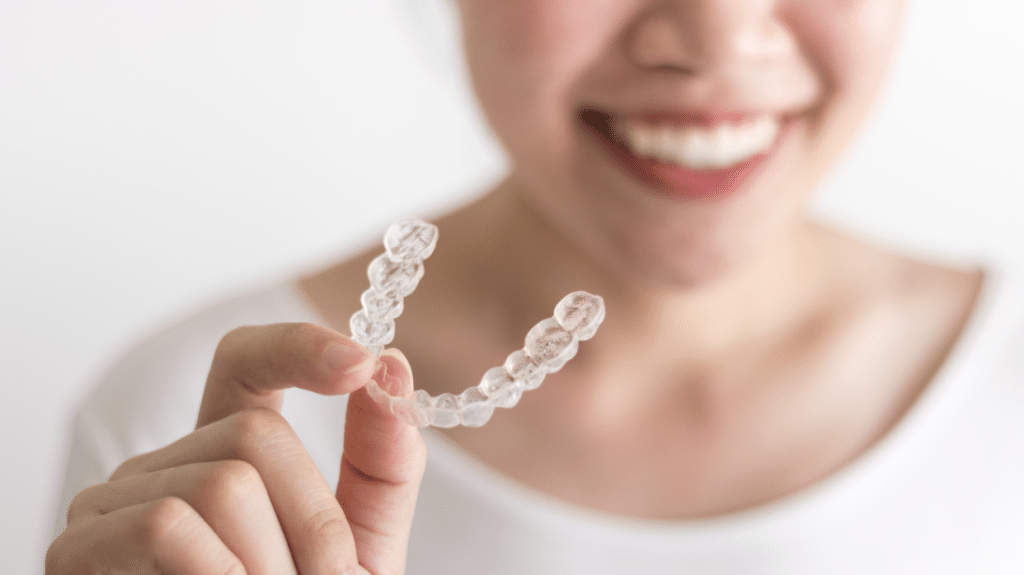
Are you thinking about improving your smile with Invisalign? For many people, it can be a great alternative to traditional metal braces! Bid did you know that just like traditional braces, the Invisalign treatment plan often includes attachments that are permanently fixed to your teeth?
Let’s take a look at what these attachments are, how they enhance the Invisalign process, and how you can take care of them. We’ll also answer some frequently asked questions, including the effectiveness of Invisalign and how long it takes for the this orthodontic treatment to work.
What are Invisalign Attachments?
Invisalign attachments may seem like minor additions to your treatment plan, but they hold significant value in the overall effectiveness of providing you with a straighter smile. These small, tooth-colored ridges, which are made from a composite material, adhere directly onto the surface of certain teeth and give your aligners something to latch onto. This extra grip allows your aligners to exert the necessary force to move teeth with greater control.
The primary role of these attachments is to facilitate complex tooth movements that would otherwise be challenging to accomplish with aligners alone. For example, certain types of rotations or tilts in tooth position could be more difficult to achieve without this added “anchor.” By giving the aligners something to grab onto, attachments make it possible to handle such intricate adjustments, widening the range of orthodontic issues that can be treated with Invisalign.
How to Invisalign Attachments Help Achieve Straight Teeth?
Now, why would you need these attachments? They come with many benefits:
Precise Movements
Invisalign attachments contribute significantly to the accuracy of the treatment process. By creating a more secure connection between the aligner and the tooth surface, these attachments enable the aligner to exert gentle pressure on the teeth during treatment. This level of precision is especially vital for ensuring that each tooth moves to its designated position.
Complex Cases
Orthodontic cases often involve complex tooth movements that are not easily accomplished with aligners alone. Attachments allow for accurate tooth rotation, which means Invisalign can treat a wider range of orthodontic issues, making it a good option for patients with more complex dental misalignments.
Faster Results
Invisalign attachments make the treatment go faster. They help the aligners move your teeth more effectively, which means you can get the beautiful smile you want in less time.
The Procedure
Getting these attachments is a straightforward process. First, your dentist will apply a composite resin bonding agent to your teeth where the attachments will go. After that, they’ll place the attachment and cure the bonding material with a special light. The whole process usually takes less than an hour.
It may take a few days to get used to them, but after awhile, you’ll hardly notice them. Since they’re made from a tooth-colored material, most others won’t notice them, either.
Duration and Care
The time you’ll need to wear the attachments depends on your specific case. It could be a few months or extend for the entire treatment. As for maintenance, it’s simple. Just continue with your usual oral hygiene routine—brushing, flossing, and using mouthwash. The attachments are robust and can withstand normal cleaning.
Tips for Success
Ready to make the most of your Invisalign journey? Keep these tips in mind:
- Compliance is Key: Wear your aligners for at least 22 hours a day for optimal results. Removing them too often can delay your treatment and lessen the effectiveness of the attachments.
- Clean Your Aligners Regularly: Rinse your removable aligners every time you remove them. Use specialized cleaning solutions or a soft-bristled toothbrush and gentle soap to clean your aligners.
- Clean Around Your Attachments: Take extra care to clean around your attachments to remove food particles and avoid tooth decay. Proper brushing should get the job done; no need to use any special tools.
- Regular Check-ups are Crucial: Schedule regular appointments with your dentist for adjustments and to ensure you’re on track with accurate tooth movement. Any misalignments or issues can be caught early during these visits, making corrections easier and quicker.
- Utilize Invisalign Accessories: Consider using Invisalign cleaning crystals or aligner chewies to keep your aligners in top shape and ensure a snug fit.
- Follow Dentist’s Instructions for Attachments: Pay special attention to any additional instructions regarding your Invisalign attachments or elastics to get the most out of your treatment.
Common Questions About Invisalign and Attachments
How long does it take for Invisalign to work? Typically, most orthodontic patients start seeing changes within a few weeks, but the total treatment time averages around 12 to 18 months.
Do teeth stay straight after Invisalign? If you follow your orthodontist’s instructions for wearing your retainer after treatment, you should be able to maintain your straighter teeth. You’ll likely need to wear a retainer all the time for the first few months, and then you can switch to wearing it only at night.
What are the stages of Invisalign? The stages generally include consultation, getting custom aligners, starting treatment with attachments (if needed), regular adjustments, and finally, the retention stage.
Can I eat with Invisalign attachments? Yes! While you’ll need to remove your Invisalign aligners while eating to prevent any damage, the attachments are held in place by the dental resin in place until your orthodontist removes them.
What if an attachment falls off? If an attachment falls off or becomes loose, contact your dentist as soon as possible to have it replaced. Missing an attachment can hinder the effectiveness of your treatment and extend the treatment period. Generally, it’s not considered an emergency, but you’ll want to get it taken care of promptly.
Are Invisalign attachments visible? Invisalign attachments are made to be as unobtrusive as possible. They’re made to match your natural tooth color and are fairly small, so they’re not highly visible. Most people find that others don’t notice the attachments unless they’re looking closely.
Conclusion
Invisalign attachments might seem like an extra step, but they’re often key to achieving the smile you’ve always dreamed of. They’re easy to get, simple to care for, and super effective. So go ahead, talk to your dentist, and start your journey to a better, brighter smile.
Dr. Kyle Eberhardt enjoys helping patients achieve better overall health through enhanced dental care. He earned his Doctor of Dental Surgery degree in 2007 and has since pursued continuing education in the field of dentistry. He is committed to lifelong learning and has received a fellowship from the Midwest Implant Institute in Ohio. He has also pursued advanced training with CEREC doctors in Arizona and North Carolina.



